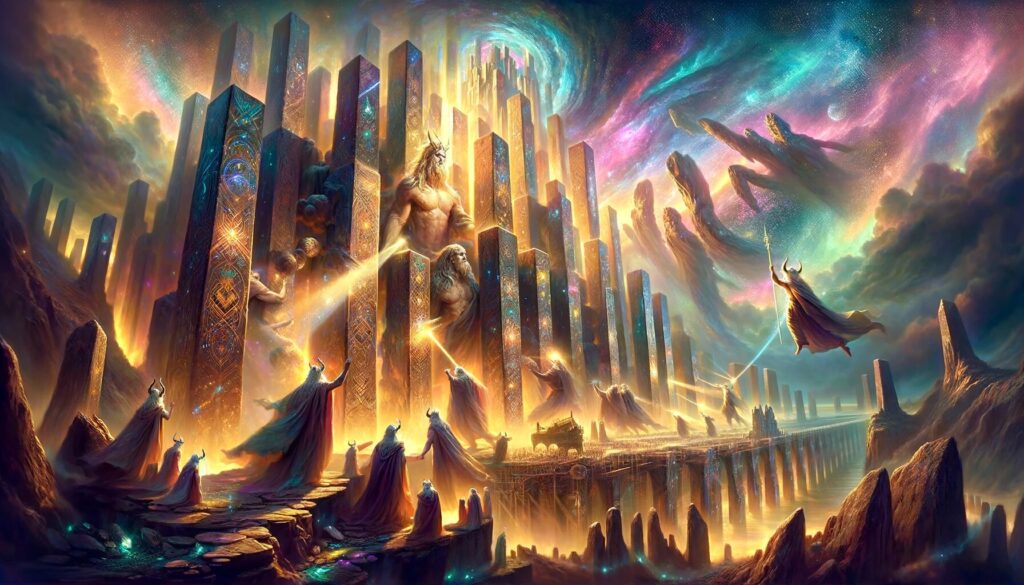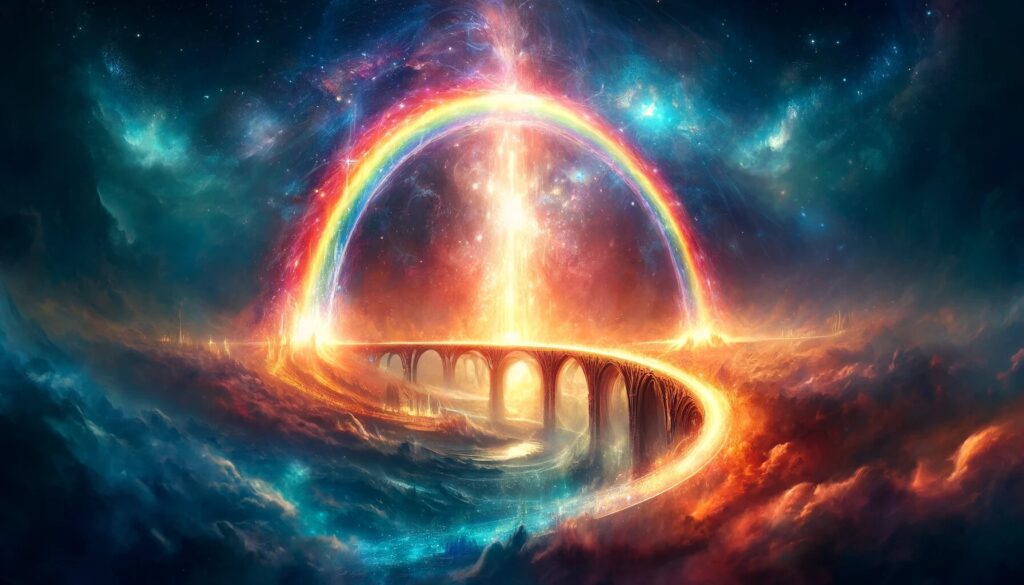Asgard, Bifrost, Norse Cosmology, Norse Mythology, Odin, Ragnarok, The Nine Worlds, Thor, Yggdrasil (World Tree)
Asgard’s Mighty Walls: Constructing the Divine Fortress in Norse Lore
Step into the realm of Norse mythology, find out what is Asgard and discover this celestial stronghold. A magnificent city constructed by the gods themselves, Asgard stands as a testament to the divine craftsmanship and power of the mighty Aesir. Its grand walls and awe-inspiring architecture make it an impregnable fortress, symbolizing its inhabitants’ divine authority and strength, including the valorous Asgardians.
In this article, we will explore Asgard’s foundations, the mythical city and its significance in Norse cosmology, and references to Valhalla. We will uncover the guardians of Asgard, Thor, and Odin, whose roles are crucial in maintaining order within the divine city. Join us as we explore the mighty walls of Asgard, delving into the rich tapestry of Norse mythology and uncovering the secrets of this celestial stronghold, including the legendary Valhalla. Get ready for an immersive journey into the heart of Asgard’s construction, Norse mythology, and the divine realm of the gods.
Exploring the Foundations of Asgard
Asgard, the mythical city of the gods, holds a central position within the realm of Norse cosmology. But where is Asgard? Situated at the heart of the Norse cosmos, Asgard represents the pinnacle of divine power and authority, home to the Æsir and revered in Old Norse culture. It is often described as a magnificent celestial fortress, with grand architecture and impressive walls that symbolize its status as an impregnable stronghold.
The Mythical City of Asgard
Asgard, as a mythical city, captivates the imagination with its divine presence. It serves as the abode of the mighty gods known as the Aesir, with the Bifrost connecting Asgard to other realms. The construction of Asgard by the gods themselves, with their immense power and divine craftsmanship, adds to its mystical allure.
Guardians of Asgard: Thor and Odin
Thor and Odin are two prominent figures associated with Asgard. Thor, the god of thunder, possesses incredible strength and serves as the protector of Asgard, standing against those who threaten the realm and its Asgardians. Known for his hammer, Mjölnir, Thor defends the celestial city with unwavering devotion, ensuring the safety of all Asgardians. Meanwhile, Odin, the Allfather and ruler of the gods, ensures the order and balance of Asgard, guiding its inhabitants with wisdom and authority from the halls of Valhalla.
Asgard’s Connection to the Nine Realms
Asgard is intricately connected to the Nine Realms in Norse mythology. These realms include Midgard (Earth), Jotunheim (realm of the giants), Niflheim (realm of ice), and others. Asgard serves as a bridge that links these realms together, maintaining the delicate balance and order of the cosmos. Its significance lies in its role as a central hub, where connection and interaction between realms occur, facilitated by the Bifrost, guarded by Heimdall.
Who Created Asgard Norse Mythology?
Deciphering the Marvel of Asgardian Realm
In Marvel’s AsgardIn the Marvel Universe, the Norse god of mischief, Loki, takes center stage as one of the most iconic characters associated with the mythical realm, influencing the fate of both Asgard and its Asgardians. Known for his deceptive nature and cunning tricks, Loki’s mischievous escapades often stir chaos and conflicts within Asgard, affecting both Æsir and Asgardians alike. Whether it’s his attempts to seize power or disrupt the lives of the gods, Loki adds a captivating dynamic to the divine realm, challenging both Æsir and Asgardians.
The Marvel Cinematic Universe (MCU) has brilliantly brought Asgard to life on the big screen, showcasing its grandeur and the lives of its inhabitants, enchanting fans of Marvel Comics. Marvel’s depiction of Asgard captures the essence of the mythical realm, highlighting its advanced technology, majestic architecture, and the complex relationships between the gods and other realms. From the golden halls of the throne room to the breathtaking landscapes, Asgard mesmerizes audiences with its visually stunning portrayal.
Bifröst, the Rainbow Bridge, is significant in Norse mythology and the MCU’s depiction of Asgard. This vibrant and celestial bridge connects Asgard to the other realms, symbolizing the seamless connection between different dimensions and worlds. As gods and beings traverse Bifröst, they embark on journeys that blur the boundaries between realms, further emphasizing the interconnectedness of the universe.
Unraveling the Enigmatic Norse Mythology of Asgard
In Norse mythology, the realm of Asgard is not immune to the cyclical nature of cosmic existence. Ragnarök, the prophesied catastrophic event, looms over Asgard, signaling the fateful end of this divine stronghold. It foretells the destruction of Asgard and the demise of many gods, including the mighty Odin and Thor. Ragnarök represents the culmination of one cosmic cycle and the dawn of a new era, showcasing the impermanence that characterizes Norse mythology and the eventual fate of both Asgardians and the Æsir.
Ragnarök: The Fateful End of Asgard
Ragnarök, the apocalyptic event, serves as a crucial turning point in the Norse mythological narrative. It is a cataclysmic battle between the forces of chaos and order that results in the utter annihilation of Asgard. This event signifies the inevitable fate that awaits even the most powerful entities in Norse mythology, highlighting the transient nature of existence.
The Aesir and Vanir in Asgardian Myths
Two distinct groups of gods populate the realm of Asgard in Norse mythology: the Aesir and the Vanir. The Aesir, associated with power and warfare, includes gods such as Odin, Thor, and Loki. The Vanir, on the other hand, embody fertility and nature, represented by divinities like Freya and Freyr, and often contrast with the martial Æsir, showcasing the diverse pantheon of Old Norse beliefs. The integration of the Aesir and Vanir in Asgardian myths signifies the merging of these two divine clans, ushering in a new era of gods and symbolizing the interconnectedness of different aspects of life.
Discovering the Vast Landscape of Asgard
Asgard’s Placement among the Nine Worlds
Asgard, the mythical city in Norse mythology, is positioned at the heart of the Norse cosmos, standing as the divine center of existence. It is often depicted as the central realm around which the other eight realms revolve. Asgard’s placement as this central hub symbolizes its paramount importance and its role in maintaining balance and order throughout the cosmos.

Yggdrasil: The Cosmic Tree in Asgardian Cosmology
Yggdrasil, often referred to as the World Tree, holds immense significance in Asgardian cosmology. This cosmic tree is intrinsically connected to Asgard, acting as a majestic bridge between the different realms. Yggdrasil’s branches extend into various regions of the Norse cosmos, serving as a conduit that allows gods and beings to traverse between dimensions and worlds. This sacred tree plays a vital role in maintaining the cosmic order, binding together the fabric of Norse mythology with its roots deeply embedded in Asgard.
Final Words
As we delve into the realms of Norse mythology, one cannot ignore the significance of Asgard. This divine fortress stands tall as the symbol of power and authority in the Marvel Universe, representing the stronghold of the gods and the center of cosmic order. Its construction’s grandeur, impregnable walls, and majestic architecture have fascinated storytellers throughout the ages and continue to captivate modern audiences.
What adds to Asgard’s allure is its intricate connection to the Nine Realms. As a bridge between different dimensions and worlds, Asgard serves as a vital link in maintaining the balance and harmony of the Norse cosmos. From Midgard to Jotunheim, the realms revolve around Asgard, highlighting its pivotal role in the grand tapestry of existence.
Furthermore, the portrayal of Asgard in popular culture, particularly in the Marvel Cinematic Universe, has brought this mythical city to life in stunning detail. From the mischievous antics of Loki to the vibrant Rainbow Bridge of Bifröst, Asgard’s portrayal in films has cemented its place in the collective imagination. It is a testament to the enduring appeal of Norse mythology and the mythical wonders of Asgard.
Asgard continues to ignite our curiosity and fascination with its mighty walls and divine inhabitants. Its significance in Norse mythology cannot be understated, for it represents not only a celestial fortress but also the embodiment of power, the center of cosmic order. As we continue to explore the realms of myth and legend, Asgard will always remain a beacon that shines brightly, inviting us to unravel the mysteries of the Norse gods and their celestial abode.


